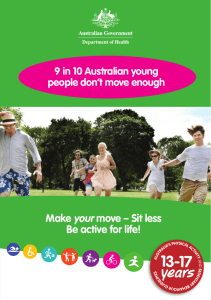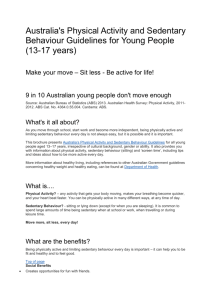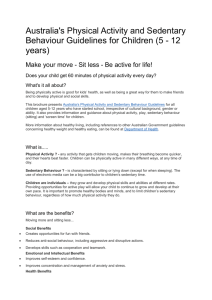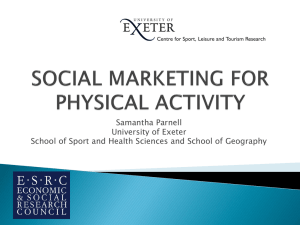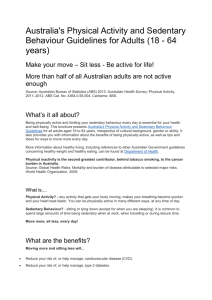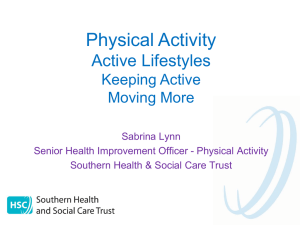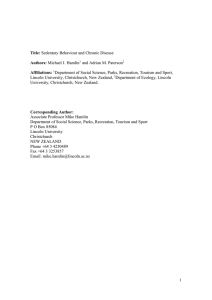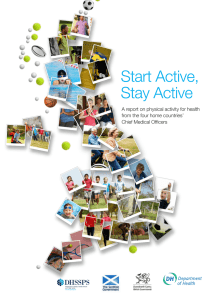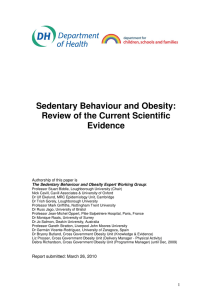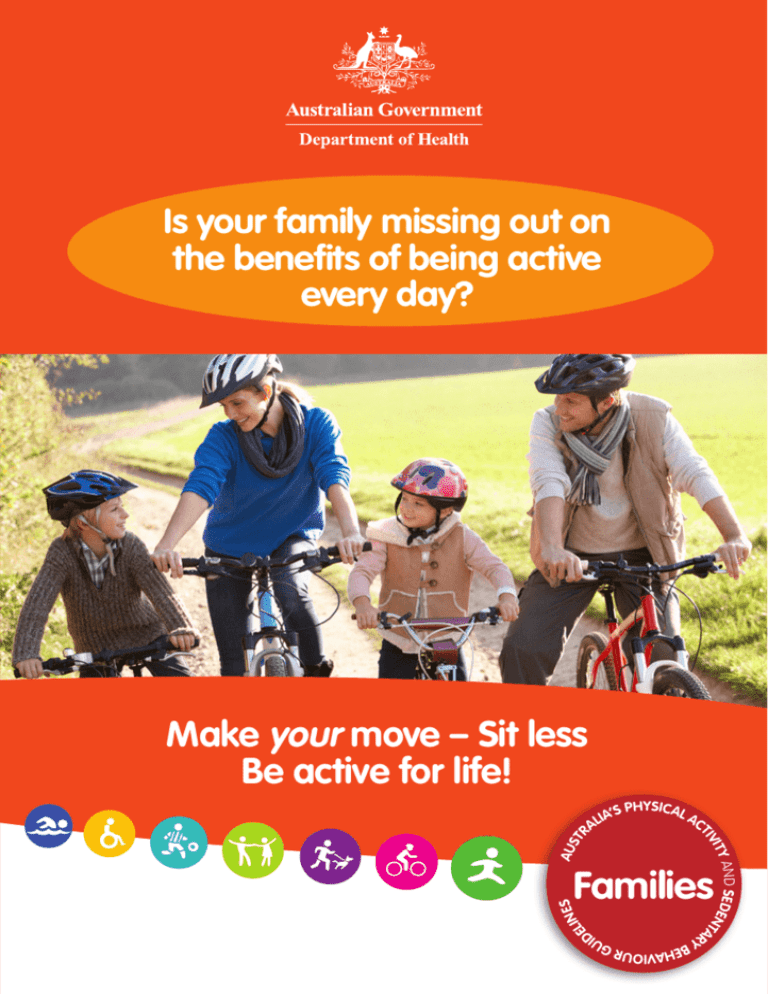
Is your family missing out on
the benefits of being active
every day?
PHYSICAL
AC
IA’S
AL
AND SEDEN
ITY
TA
TIV
AUS
TR
Make your move – Sit less
Be active for life!
RY
S
INE
EL
Families
AVIOUR G
UI
BEH
D
What’s it all about?
Being physically active and limiting sedentary behaviour every day is
good for your health and has other benefits too. This brochure provides
you with information about the benefits of being physically active, and
offers steps that you and your family can take towards better health, at
any age. You will find information for everyone – infants and toddlers,
children, young people and adults too, as well as tips and ideas for being
more active and less sedentary every day.
More information about healthy living, including references to other
Australian Government guidelines concerning healthy weight and
healthy eating, can be found at www.health.gov.au
THE BENEFITS OF AN ACTIVE LIFE
Doing any regular physical activity is better than doing none. Look for
ways to add physical activity and to limit sedentary behaviour in your
day and be a good role model for your family.
Encouraging kids to be active each day establishes good habits that
can stay with them throughout their lives.
REGULAR PHYSICAL ACTIVITY CAN:
• Provide families with opportunities to have fun together.
• Make you feel good.
• Help you to relax.
• Improve self-esteem and confidence.
• Help to prevent unhealthy weight gain and assist with weight loss.
• R educe the risk of developing, and help manage, cardiovascular
disease.
• R educe the risk of developing, and help manage, type 2 diabetes.
• Reduce the risk of, and assist with rehabilitation from, some cancers.
• Help to build strong bones, muscles and joints.
• Promote healthy growth and development.
Move more, sit less, every day!
Be physically active every day
Our bodies are designed to move from
the minute we are born. The easiest way
to be more physically active is to include
a variety of activities as part of your
family’s routine. Remember to ensure that
the activities you and your family do are
age and development appropriate.
If you are not currently doing any
physical activity, you will benefit from
starting some activity, and gradually
increasing the amount you do. Trying
out new activities as a family can be
fun and rewarding.
INFANTS (BIRTH TO 1 YEAR)
Physical activity – particularly supervised floor-based play in safe environments – should be
encouraged from birth.
TODDLERS (1–3 YEARS) & PRE-SCHOOLERS (3–5 YEARS)
Be physically active every day for at least three hours, spread throughout the day.
CHILDREN (5–12 YEARS) & YOUNG PEOPLE (13–17 YEARS)
•
•
•
ccumulate at least 60 minutes of moderate to vigorous intensity
A
physical activity every day.
o a variety of aerobic activities, including some vigorous
D
intensity activity.
E ngage in more activity – up to several hours per day, for additional
health benefits.
ADULTS (18–64 YEARS)
•
•
D
oing any physical activity is better than doing none. If you currently do no physical
activity, start by doing some, and gradually build up to the recommended amount.
A
ccumulate 150 to 300 minutes (2½ to 5 hours) of moderate intensity physical activity or
75 to 150 minutes (1¼ to 2½ hours) of vigorous intensity physical activity, or an equivalent
combination of both moderate and vigorous activities, each week.
MODERATE INTENSITY ACTIVITIES
VIGOROUS INTENSITY ACTIVITIES
E.g. brisk walking, recreational
swimming, dancing, social tennis, riding
a bike, golf, household tasks like cleaning
windows or raking leaves, or playing
active games.
E.g. jogging, fast cycling, many organised
sports, or tasks that involve lifting, carrying
or digging.
take some effort, but you are still able
to talk while doing them.
require more effort and make you breathe
harder and faster (‘huff and puff’).
Being physically active will make you breathe more quickly and your heart beat faster.
Limit sedentary behaviour
Sedentary behaviour is the time you
spend sitting or lying down, except
when you are sleeping. To reduce the
risk of poorer health outcomes, including
type 2 diabetes everyone should limit
their sedentary behaviour every day.
Even if you are physically active every
day, you will still benefit from minimising
sedentary behaviour at home, at work,
during travel and for leisure.
CHILDREN (0–5 YEARS)
Should not be sedentary, restrained,
or kept inactive, for more than one
hour at a time, with the exception
of sleeping.
CHILDREN (5–12 YEARS),
YOUNG PEOPLE (13–17 YEARS)
& ADULTS (18–64 YEARS)
•
•
M
inimise the time spent being
sedentary every day.
B
reak up long periods of sitting
as often as possible.
There are some activities, like reading, doing school work,
working on a computer, or travelling, that may need to
be done while you are sitting. The key is to find a healthy
balance, and to look for opportunities to stand up and
move whenever you can.
What is ‘screen time’?
Stand up for yourself!
Time spent using
electronic media
(such as television,
seated electronic
games, portable
electronic devices
or computers) for
entertainment, is
referred to as ‘screen time’.
While screen time activities may be popular,
they usually involve either sitting or lying
down for long periods.
CHILDREN AGED LESS THAN 2 YEARS
Should not spend any time watching
television or using other electronic media
(DVDs, computer and other electronic games).
CHILDREN AGED 2 TO 5 YEARS
Sitting and watching television and the use of
other electronic media (DVDs, computer and
other electronic games) should be limited to
less than one hour per day.
CHILDREN (5–12 YEARS) &
YOUNG PEOPLE (13–17 YEARS)
Limit use of electronic media for
entertainment (e.g. television, seated
electronic games and computer use) to no
more than two hours a day – lower levels are
associated with reduced health risks.
You can limit your
family’s screen time by:
Allocating specific time
periods for electronic
media use, preferably not
during daylight hours when
you can be active outside.
Rewarding good
behaviour with active
family time, rather than
with electronic media use.
Turning off the TV,
especially during
meal times.
Making bedrooms TV
and computer free zones.
Storing portable
electronic devices,
such as phones, tablets
and electronic games,
out of sight.
Setting a good
example – reduce your
electronic media use for
entertainment.
What about
strength?
Regular muscle strengthening activities
can benefit all members of your family,
from infants to adults. Doing activities
to build strong and healthy muscles
and bones can help:
• P revent and control heart disease and
type 2 diabetes.
•M
anage blood pressure, blood sugar
and blood cholesterol.
• Improve posture, mobility and
balance.
•M
aintain functional status and the
ability to do everyday activities.
CHILDREN (5–12 YEARS) &
YOUNG PEOPLE (13–17 YEARS)
Do activities that strengthen muscle
and bone on at least 3 days each week.
ADULTS (18–64 YEARS)
Do muscle strengthening activities on
at least 2 days each week.
GROWING STRONGER
Help children to grow strong bones
and muscles by encouraging them to:
• Skip, hop, run, and jump.
• Climb and swing.
• P lay games like tug-o-war
and hopscotch.
• T ry more structured activities
like dance, gymnastics or
martial arts.
Participating in a variety of physical
activities, especially dance, aerobics or
martial arts, will help to build strength.
For young people and adults, there are
also many body weight exercises like
sit-ups, push-ups, lunges and squats,
or hand-held weight exercises that can
be done at home.
Move more, sit less, every day!
ACTIVE FAMILIES
Set aside time to be active together as a family – visit
playgrounds, parks, nature reserves, ovals or beaches.
Trying out new activities can be fun and rewarding.
On rainy days, try a dance competition in the lounge
room with the kids, play games with balloons or soft
balls inside, or visit an indoor swimming pool.
CHILDREN 0–5 YEARS
Children grow at different rates and develop physical skills at varying times,
but regular physical activity is important and young children should be given
plenty of opportunities to be active.
Physical activity for young children includes both structured activities and
unstructured free play, and it can be done indoors or out.
CHILDREN 5–12 YEARS
There are many activities that children can do as part of their 60 minutes
of physical activity every day. Your children may enjoy organised sports
like soccer, netball, basketball or swimming, or they may prefer riding their
bike or scooter, playing a game of tag, throwing a frisbee or jumping rope.
Remember, your child’s 60 minutes of physical activity can be accumulated
throughout the day.
YOUNG PEOPLE 13–17 YEARS
Physical activity does not have to be organised or competitive to be
beneficial – social activities with family and friends, or being active by
yourself can be lots of fun and have many benefits. Using active modes
of travel, like walking or riding a bike or skateboard safely, are a great way
for young people to be active.
ADULTS 18–64 YEARS
Doing any physical activity is better than doing none. If you are not currently
physically active, start with some activity and gradually increase the amount
you do. Remember the more activity you do each week, the better.
Be active every day in as many ways as you can!
Australia’s Physical
Activity and Sedentary
Behaviour Guidelines
• Move and Play Every Day – National
Physical Activity Recommendations for
Children 0-5 Years.
• M
ake your move – Sit less – Be active
for life!
- Children (5-12 years)
- Young People (13-17 years)
- Adults (18-64 years)
-Families
OTHER HEALTHY LIVING RESOURCES:
• Healthy Weight Guide –
www.healthyweight.health.gov.au
• Eat for Health – www.eatforhealth.gov.au
• Clinical Practice Guidelines for the Management
of Overweight and Obesity in Adults,
Adolescents and Children in Australia –
www.nhmrc.gov.au/guidelines/publications/n57
• Get Up & Grow – Healthy Eating and
Physical Activity for Early Childhood (for centre
based care, family day care and pre-schools) –
www.health.gov.au
• C
hoose Health: Be Active – A physical
activity guide for older Australians.
To find out more, go to
www.health.gov.au
© Commonwealth of Australia 2014, except for the images/photographs which are reproduced under licence. All rights are reserved,
unless permitted by the copyright Act 1968 (Cth). All information in this publication is correct as at June 2014
10141 June 2014
To order these resources
FREE OF CHARGE,
phone 1800 020 103

